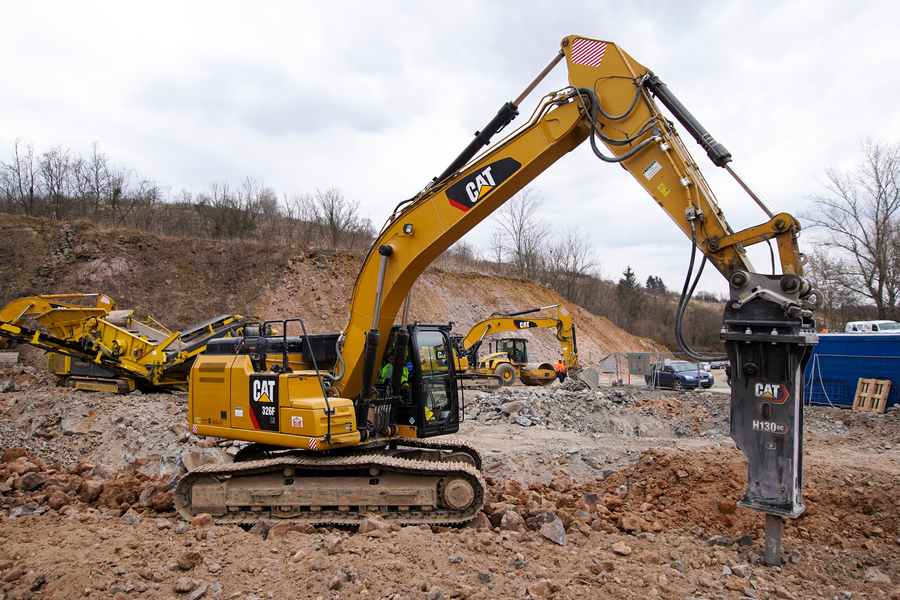What is Hydraulic Hammer for Excavator and How Does It Work?

Table of Contents:
1. How Are Excavator Hydraulic Hammers Built?
2. How Do Hydraulic Breakers Work?
3. Types of Hydraulic Hammers
4. Why Should You Get a Hydraulic Hammer?
5. Your Trusted Supplier of Hydraulic Hammers
Dating back to 1967, hydraulic hammers are the oldest hydraulic attachments on the market. Hydraulic hammers are often referred to as hydraulic breakers. As the name indicates, their main function is to break through the material. They are then perfect attachments for such works as demolition, trenching, asphalt cutting, or rock excavation. Throughout the years, hammer attachments evolved and as a result, there are many various makes, models, sizes, and types available on the market. Today's article gives you all you need to know about hydraulic hammers.
How Are Excavator Hydraulic Hammers Built?
There are two types of hydraulic hammers, inner valve type, and outer valve type. The most crucial part of the hydraulic system is the cylinder. Both types of hydraulic hammers also have a piston. It converts kinetic energy into hammering energy.
Any proper excavator jack hammer has a fully enclosed cover, called housing. This cover protects the parts and ensures their prolonged durability. Apart from the hammer's durability, the safety of the machine it is attached to is also of significant importance.
That is why many models also have shock absorbers, which protect the machine from impact. The shock absorber also constitutes protection. Many models also have a steel bushing in the bottom that protects the equipment from vibration.
This specific build and the mechanism of work make hydraulic breakers a popular choice for those who need equipment that provides less vibration and noise. They are also environmentally friendly because they produce less pollution.
How Do Hydraulic Breakers Work?
Hydraulic breakers use the principle of hydraulics in their work. The rule says that if the pressure is applied on one part of a fluid, that pressure is transferred to all areas of the fluid. As a result, the used force is multiplied. When this rule is applied to incompressible, the result is a transfer of power with a minimal loss.
The oil is supplied to the hammer through the valve in the cylinder. At the moment of an upward stroke, the pressure builds up in the upper chamber and is released by the main valve. On the other side, the release of high pressure in the lower chamber causes the piston to move upwards. Next, the upper chamber becomes the high-pressure one and the piston moves downward. These changes in pressure are called impact stroke changes. and generate a lot of energy - the same energy the tool uses to complete various demolition jobs.
Types of Hydraulic Hammers
To appropriately choose the right hammer for the demolition project it is necessary to understand the differences between the types. Thanks to that maximum efficiency and lowered operating costs can be achieved with every job. The main distinction between hydraulic hammers is their size:
1. Mini hammers - their working weights range between 400 and 1200 pounds. The design makes them perfect for minor and indoor projects. The small size also results in greater efficiency and easier operation than large models.
2. Medium hammers - these are the most popular hammer types, perfect for large concrete works, or utility projects. These hammers are very versatile due to their significant impact and efficiency. Medium-class hammers have working weights between 1900 and 3700 pounds.
3. Large hammers - they are characterized by high impact and less frequency than smaller hammers. Therefore, they are perfect for large excavation works and demolition projects. The working weight of this type of attachment range between 5000 and 7500 pounds.
Why Should You Get a Hydraulic Hammer?
You may wonder why a hydraulic breaker is so popular when there are many more hydraulic attachments on the market. Let us have a look at the most important benefits of hydraulic breakers:
1. Versatility - hydraulic hammers provide added flexibility and therefore flexibility to excavators, backhoe loaders, or skid-steer loaders.
2. Productivity - thanks to their power, hydraulic breakers decrease the amount of manual labor.
3. Traditional power attachments provide significantly less impact force than hydraulic parts.
4. Durability - among many benefits long service life is one of the biggest advantages of hydraulic hammers.
5. Efficiency - compared to air-powered models, hydraulic parts have improved efficiency thanks to fuel.
6. Fewer parts - there is no need for an air compressor or long hoses when using a hydraulic hammer.
7. Safety - there is significantly less noise and fewer accidents when using hydraulic hammers than manually operated ones.
Your Trusted Supplier of Hydraulic Hammers
The best hydraulic attachment may be worthless if it is not of the highest quality. Luckily, our shop carries attachments manufactured in the USA of the highest quality steel. Skidsteers.com offers not only hydraulic hammers for excavators but also skid steer loaders. Visit our shop to choose the best attachment that perfectly suits our needs. Unsure which attachment to choose? Get in touch! Our friendly customer service team will be happy to help you.

